Abstract
The imperative demands placed on modern business management necessitate the exploration of novel approaches to adapt, innovate, and ensure effectiveness and efficiency. The integration of art into business management aligns with this rationale, indicating a trend towards art’s incorporation into various managerial dimensions. As a discipline primarily focused on understanding managerial practices, management science has been investigating the utilization of art in the workplace since the early 2000s. The subject of art in the business environment has garnered various names and significant attention as a major trend. Through bibliometric analysis, we can characterize the evolution of scientific production and map the prevailing ideas in this field. By examining a sample of 69 articles retrieved from the Scopus database, this study lays the foundation for structuring art-based managerial thinking, while acknowledging certain limitations that may guide future research endeavors.
1. Introduction
In the realm of traditional business discourse, the spheres of business management and art have long been cast as adversaries. While management is often imbued with notions of rationality, utility, and efficiency, art exudes an aura of inspiration, creation, and sensitivity (Debenedetti and Perret 2019; Thévenot and Boltanski 1991). However, amid this perceived dichotomy, a fascinating and transformative phenomenon is unfolding, as enterprises progressively turn to artistic practices.
The fusion of art and management has transcended the mere surface allure of aesthetic elements, such as product design, spatial aesthetics, and brand logos, which lend an artistic ambiance to corporate spaces. Present-day management has ventured boldly beyond these conventional aesthetics, embracing art in its most operational and strategic manifestations. A striking illustration of this transformation lies in the metamorphosis of banks, once relegated to being rational entities offering financial services, into all-encompassing domains of affective well-being and cultural influence (Bargenda 2019). This metamorphosis also opens the gateway to cultivating an authentic corporate identity (Pluchart 2017; De Molli 2019).
In the contemporary landscape, a multitude of enterprises have come to discern the added value that art imparts to their management and developmental pursuits (Koronaki et al. 2018). Artistic approaches now serve as fertile ground for fostering innovation, nurturing creativity, and nurturing divergent thinking within corporate teams (Carlucci and Schiuma 2018; Sandberg 2019). Art, wielding its formidable communicative prowess, serves as a potent vehicle to convey intricate messages, forging deep connections with employees and customers alike, especially in the realm of products and services harmoniously intertwined with artistic essence (Gupta and Joshi 2023).
Enterprises, venturing further into bold territories, have engaged in audacious collaborations with artistic minds to reconceptualize management paradigms, emboldening explorations into uncharted vistas, and deftly addressing organizational challenges through innovative means (De Groot 2020). These harmonious unions between art and management harmoniously blend the pragmatism and utilitarianism of management with the visionary scope and imaginative sensitivity of art, unhindered by restrictions, evoking boundless inspiration and novel solutions (Grant 2017; Sandberg 2019).
In sumptuous harmony, management and art, once perceived as antipodes, now delight in an enchanting pas de deux, as corporations progressively integrate art into their practices, not merely to gratify aesthetic sensibilities, but to ardently embrace the manifold operational and strategic benefits it confers. This captivating amalgamation propels explorations into uncharted territories, fosters ingenuity and innovation, and fervently kindles the commitment of stakeholders (Lipovetsky and Serroy 2013).
Among the discerning cadre of modern-day entrepreneurs, the allure of art as a catalyst for elevating management practices has assumed an unmistakable prominence (Ferreira 2018). The evaluation of this elevation predominantly centers around time-honored management concepts, including performance and directionality, infused with the potent alchemy of managerial tools designed to actualize predetermined objectives and discerningly assess their realization.
The contemporary phenomenon of the “aestheticization” of management and leadership (Phanuel 2021a) bears witness to a mesmerizing infusion of artistic interventions into the corporate milieu, donning diverse forms. These captivating artistic interventions hold the power to profoundly impact an organization’s deeply entrenched cultural routines and perspectives (Cheng et al. 2018).
It is within this context of resolute innovation and the pursuit of distinction in a fiercely competitive landscape that companies justify the seamless infusion of artistic practices into their efficiency-driven and utility-centered environments.
It is highly challenging to create a comprehensive inventory of companies’ motivations for employing art as a tool to achieve performance objectives. The difficulty primarily arises during the data collection phase, mainly due to the limited sample sizes, the nature of surveys, and their feasibility. Nevertheless, conducting a bibliometric analysis presents an excellent opportunity to closely relate the theme of arts-based management or art-based management to the major currents of management science. Additionally, it helps to gain a better understanding of the connections between previous works on arts-based management.
According to Ferreira (2018), the initial academic research on arts-based management involved a literature review on the role of art in the entrepreneurial field, carried out by Antal and Strauss (2013). However, this literature review did not utilize bibliometric analysis. As a result, Ferreira conducted the first bibliometric analysis in this field, performing a systematic review of 137 scientific articles published between 1973 and 2015.
This work is remarkable for its originality in selecting keywords. The recent emergence of concepts such as arts-based initiatives and artistic intervention has piqued specific interest, focusing on a limited number of specific keywords in a precise field.
1.1. Arts-Based Management: A Literature Review
From the evolutionary perspective of modern companies, management practices are constantly undergoing metamorphosis (Le Bas 2019). This evolution is characterized by openness to new territories and frontiers.
In this regard, the integration of art into an organizational context primarily focused on rationality and efficiency serves as a perfect example of this dynamic. The inclusion of art in business settings allows for an examination of the hidden, softer dimensions of day-to-day management while attempting to comprehend its functioning. This essentially requires imagination to fuel creativity and an awareness of the emotions that underpin human communication and all managerial activities.
1.2. Arts-Based Management: A Generic Concept
Arts-based management is a broad concept that has intrigued experts in terminology. According to Ferreira (2018), “art” is defined as a particular form of striving for excellence. In managerial terms, this pursuit of excellence can be translated into performance, effectiveness, and efficiency. Despite their differences, the realms of art and management can complement each other.
Chia (1996) and Schiuma (2011) highlight the potential for art to offer new perspectives in the current managerial environment (Ferreira 2018). However, there is currently no universally accepted definition of arts-based management in academia, and different authors have diverse opinions on its application in management or business.
An example illustrating the fusion of art and management can be seen in the crucial roles of effective human communication and the consideration of employees’ emotions for the smooth functioning of organizations (Nissley 2010; Ferreira 2018). This aligns with the essence of art as a source of inspiration and a conduit for sensitivity and emotion. Consequently, the concept of “aestheticization” of management gains further credibility and support.
In contrast, the management science literature identifies art through various concepts, such as arts-based initiatives, artistic intervention, and arts-based methods, as discussed above. However, these concepts are interconnected in numerous ways.
1.3. Arts-Based Methods (ABM): A Managerial Practice in the Making
The initial exploration of art in management was conducted by Adler (2006), who used the term “art-based approaches” to describe the practices of certain companies and business leaders in their utilization of art. An illustrative example provided by Adler is that of Stef Wertheimer, an industrialist and founder of the Tefen industrial park, who successfully built industrial parks that fostered collaboration between Arabs and Druze communities, resulting in highly profitable ventures (Adler 2006).
Art-based methods have been defined by various authors in different fields. For instance, Fraser and Al Sayah (2011) defines art-based research in the medical field as methods incorporating art, where art plays a significant role either in specific research stages or throughout the entire research process.
Likewise, Barone and Eisner (2012) conceptualize these art-based methods (such as poetry, storytelling, and photography) as a process of knowledge production, wherein art forms such as music, photography, crafts, poems, and drawing play a pivotal role in communicating experiences, thoughts, ideas, values, beliefs, and knowledge (Strand et al. 2022).
In the domain of managerial education, authors such as Homayoun and Henriksen (2018), Katz-Buonincontro (2018), and Taylor and Ladkin (2009) also present art-based methods as forms of art-based research.
The management science literature views arts-based methods as arts-based qualitative research methods (Debenedetti et al. 2019). Research has explored the potential links between art-based methods and creativity as essential skills in managerial and industrial spheres (Berthoin Antal et al. 2019). Scholars such as Sutherland (2013) examined the possibility of art being an endogenous variable for explaining leadership through aesthetic reflection, utilizing qualitative methods closely aligned with the art world. Leavy (2018) later emphasized the shared craft dimension between artistic and qualitative approaches (Debenedetti et al. 2019).
This approach is justified for two reasons:
- (1)
- The use of art originated from research in managerial education sciences and manager training techniques, particularly in the field of leadership (Berthoin Antal et al. 2019). Early work by Sutherland (2013) explored the potential of art as an explanatory variable for leadership through aesthetic contemplation, relying on qualitative methods closely related to the art domain. This convergence was later emphasized by Leavy (2018), highlighting the common craft dimension between artistic and qualitative approaches (Debenedetti et al. 2019).
- (2)
- Researchers are striving to propose unconventional tools, particularly to cope with environments characterized by chaos and uncertainty. These tools offer advantages in replacing traditional methods based on a stable, knowable world (Weick 2007; Taylor and Ladkin 2009).
Darsø (2004) suggests that these methods can be a source of value creation for companies, serving as a catalyst for creativity among managers (Antal et al. 2018). This role is increasingly sought to meet the demands of the fourth industrial revolution (Schiuma 2017) by creating an organizational environment that fosters human potential to meet business needs, stimulate creative thinking, and contribute more meaningfully to society. As such, a win-win collaboration between the realms of art and business becomes a necessity rather than an optional choice for managers.
1.4. Arts-Based Initiatives (ABI): Towards an Attempt at Identification
Schiuma (2009) was the pioneer in identifying the concept of arts-based initiatives (ABI) as the utilization of art within an organizational context. These initiatives encompassed various activities, such as theatrical performances, museums, galleries, and art exhibitions, among others. Further elaborating on ABI, Schiuma (2011) described it as an experiential immersion process, engaging individuals both rationally and emotionally through their active or passive involvement in specific activities.
The effects of these initiatives have been examined by Schnugg (2011), who identified seven key positive outcomes resulting from arts initiatives adopted by companies (Phanuel 2021b). These effects include personal development, team-building, organizational development, enhanced communication skills, utilization of arts as a medium, external communication of corporate image, and improved organizational performance.
While recent research on arts-based initiatives has primarily focused on their impact as beneficial management tools for managers, only a few articles have explored the contributions of artists to companies. Biehl-Missal and Antal (2011) acknowledges that some work has been performed in this area, notably by Brellochs and Schrat (2005), Ferro-Thomsen (2009), Antal (2009).
1.5. Artistic Intervention: Immersing Art in Management
The concept of artistic intervention has not been limited to just management science but has been explored in various research fields. For instance, in the context of urbanism, art has been instrumentalized in gender and space studies, as seen in Skoglund and Holt’s (2021) work has been studied for its potential as a form of democratic expression in urbanism, as explored by Vergara-Perucich (2021). Müller (2019) also delved into the role of art and artists in creating a just city.
In the domain of management science, the literature presents artistic interventions as the integration of art within a company, followed by its integration into management practices to achieve predefined objectives. Cheng et al. (2018) adopt a triangulation approach to study how art can act as a catalyst for innovation through the involvement of artists within the company, focusing on organizational routines and operations. Additionally, artistic interventions within companies can provide meaning for employees, as demonstrated by Antal et al. (2018).
Zambrell (2016) focuses on artistic interventions that can foster a process of identity affirmation, particularly in the context of identity construction among managers in the workplace.
1.6. Art Infusion Phenomenon
The utilization of art in a managerial context has been extensively studied in the literature, particularly in the domain of marketing and sales, where it is known as “art infusion”. Previous marketing research has considered art as a distinct field of interest and a unique category of consumption (Joy and Sherry 2003; Hagtvedt and Patrick 2008).
The concept of art infusion was first explored by Hagtvedt and Patrick (2008), who investigated how the presence of art influences consumer perception. The study revealed that visual artworks positively impact consumers’ perceptions of non-artistic products associated with the artworks, particularly through advertising or product design.
In addition to its impact on consumer perception, art infusion can add value to a company’s marketing efforts. Estes et al. (2018) empirically tested an emotion-based model, explaining how artworks in advertisements can enhance the perceived value of a product (art infusion effect).
Furthermore, Cuny et al. (2020) examined the effects of art infusion on customers’ brand attachment, using a sample of 258 students from leading business schools. The study aimed to test the moderating effect of an artistic experience linked to a brand. The art infusion phenomenon suggests that exposure to artworks enhances the perception of luxury associated with brands, but this effect is contingent on the cultural congruence between the brand’s country of origin and the country of origin of the artwork used in the infusion experiment (Seo et al. 2022).
These trends are in line with Cheng et al.’s (2018) research, in which artistic intervention is defined as the introduction of art into a work environment, influencing an organization’s culturally embedded routines and perspectives. The notion of artistic intervention aligns with Schiuma’s (2011) definition: “Artistic interventions in organizations, sometimes called arts-based initiatives, consist of introducing people, products, or practices from the art world into organizations that are not intrinsically art-related” (Antal et al. 2018).
2. Materials and Methods
Among the various methodologies employed by researchers, bibliometric analysis is considered an essential tool for assessing scientific productivity and evaluating research quality within a specific field (Rodríguez-Bolívar et al. 2018). Gao et al. (2018) define bibliometrics as a quantitative analysis that utilizes statistical measures and literature to evaluate a given topic.
Bibliometric analysis relies on two primary techniques: bibliometric performance indicators and scientific mapping. The former allows for the evaluation of the authors’ output, journal contributions, and the origin of a specific theme. On the other hand, scientific mapping, based on bibliographic coupling and term co-occurrence, facilitates the generation of bibliometric networks. Through this analysis, the relationships between authors and keywords can be studied, enabling the association of different fields and trends, and aiding in the identification of future research directions. These findings are often visually represented through maps, making bibliometric analysis a valuable tool for data analysis and presentation (Ferreira et al. 2016; Ferreira 2018; Merigó et al. 2015).
In recent years, such studies have gained popularity within the scientific community, especially with the advent of comprehension-aiding software capable of handling vast amounts of information. Widely used tools, such as VOSVIEWER and R Studio, have become prevalent, due to their user-friendly interfaces and open-source nature.
The selection of articles for this study was based on 69 publications obtained from the Scopus base platform. The sample was generated through a query that incorporated three keywords: “arts-based management”, “artistic intervention”, and “arts-based initiatives”. The search targeted keywords, abstracts, and titles of scientific publications within the management sciences domain exclusively, spanning the years 2006 to 2023.
3. Results
3.1. Sample Overview
The study sample offers a rich source of data to investigate the connection between art and business. The involvement of 111 authors in this field indicates the keen interest of the academic community in unraveling the intricacies of this relationship. The presence of publications from 33 diverse sources across various countries, coupled with a growth rate of 4.16%, signifies the advancement of scholarly discourse on the subject. This progress is facilitated by an indirect interconnection between the authors, fostering the exchange of ideas and insights in the field.
Despite the interest of the arts in management and business, scientific production in this field has been declining. The figure (Figure 1) shows a decline in production in this area after a peak in 2015.
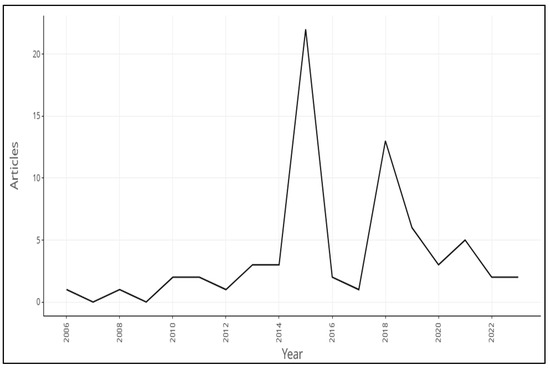
Figure 1.
Scientific production per year by R Bibliometrix.
Regarding the average number of citations per year, the scientific output concerning the use of art in an organizational context experienced its peak in 2010, and it reached an even higher level in 2017, with an average of six citations per year. However, there has been a decline in the number of citations from 2017 onwards (Figure 2).
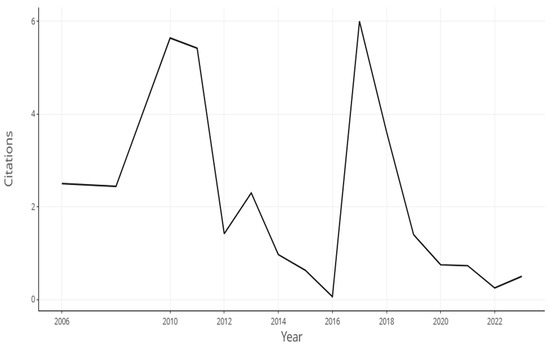
Figure 2.
Average citation per year by R bibliometrix.
For example, the notion of the infusion of art into enterprise has taken the following path over the last ten years (Figure 3):
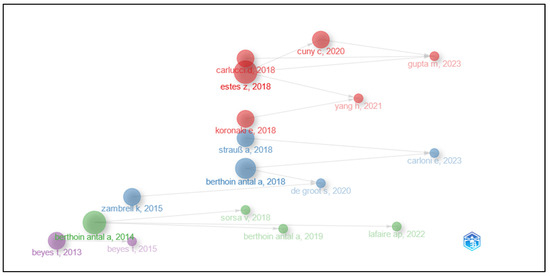
Figure 3.
Example of the evolution of research in the field of art and management by R Bibliometrix.
An examination of the Top 10 keywords (Figure 4) found in the titles of the relevant articles revealed that the term “artistic intervention” (including “Artistic intervention” and “Artistic interventions”) is the most prevalent, constituting 46% of the occurrences. Following closely is “arts-based initiatives”, accounting for 8% of the occurrences.
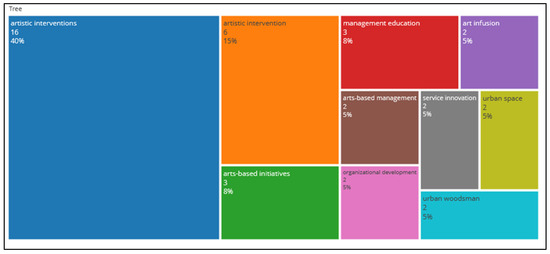
Figure 4.
Top ten keywords tree by R Bibliometrix.
Continuing with this title-based analysis approach, the results obtained from the R Studio software can be utilized to construct a three-field plot, enabling the simultaneous visualization of three variables (Figure 5). The term “Artistic Intervention” emerges as the most commonly utilized keyword by authors, particularly prevalent in the Journal of Business Research, which holds a prominent position in comparison to other journals (a more comprehensive journal analysis can be found in Section 3.3).
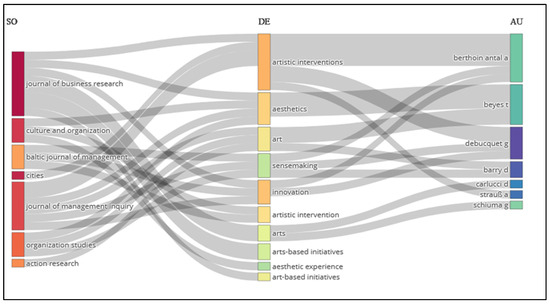
Figure 5.
Three-field plot (review-keyword–author).
- a.
- Bibliographic coupling:
In this section, we present bibliographic coupling analyses for authors, articles, and journals. Bibliographic coupling refers to the degree of linkage between two articles based on their shared references to the same article.
- i.
- Bibliographic coupling through articles:
Upon examining the 69 articles in the sample and applying a minimum threshold of two citations per document, we identified 59 items (representing 85.5% of the sample) with interconnections among them (Figure 6). The substantial number of connections emphasizes the significance of the links among the selected items (Figure 7).
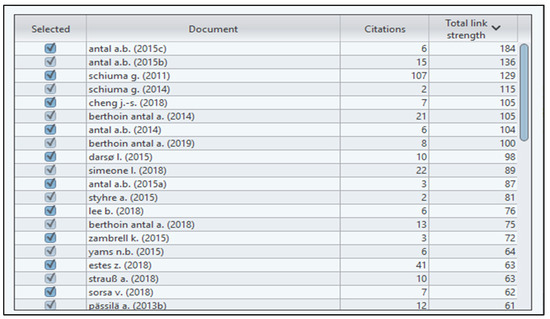
Figure 6.
Bibliographic coupling of articles.
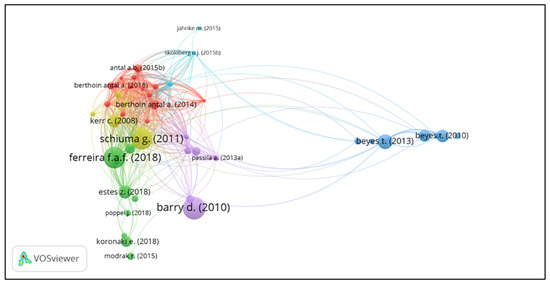
Figure 7.
Network diagram for bibliographic coupling of articles.
3.2. Bibliographic Coupling through Authors
Analysis of the sample through bibliographic coupling shows that of the 69 articles, there are three outstanding authors (Figure 8).

Figure 8.
Number of articles per author.
Berthoin Antal is responsible for 101 articles. The author has developed her thinking in a progressive manner. First, she identified a link between art and management, sketching out a typology of these practices. Next, she studied the added value of these practices, demonstrating an evolution towards the construction of a solid reflection on the subject.
Another notable author is Schiuma, who has written six articles marking an intellectual dynamic focused on proposing a definition of the use of art in an organizational context, as well as on the added value of art in enterprise. These articles also address the justification for this mobilization.
The authors included in the sample come from different research structures, including interdisciplinary structures, and from different nationalities (Figure 9). This interdisciplinary diversity may be at the root of scientific reflection on the relationship between art and management.
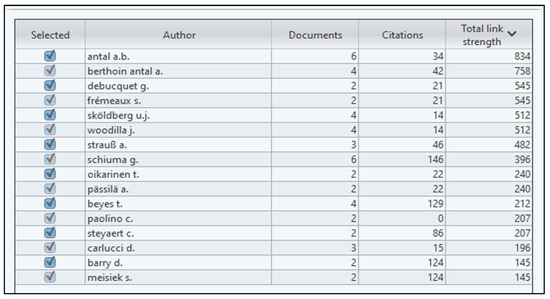
Figure 9.
Analysis of bibliographic coupling.
Another key author interested in this relationship is Beyes, with a total of four articles. The line of thought of these articles forms a distinct cluster. This author’s main interest lies in the aesthetic aspect within organizations in general, and more specifically in the field of management (Figure 10). However, unlike other perspectives, Beyes believes that art is not a means in itself and should not be used as a management tool.
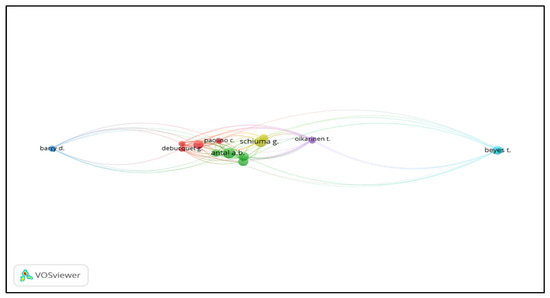
Figure 10.
Network diagram of bibliographic coupling by author.
3.3. Bibliographic Coupling through Sources
With a minimum threshold of two articles per journal exploitation of the sample yielded eight journals. “Artistic intervention in organization” and “Journal of business research” are the two journals with the most publications and links (Figure 11).
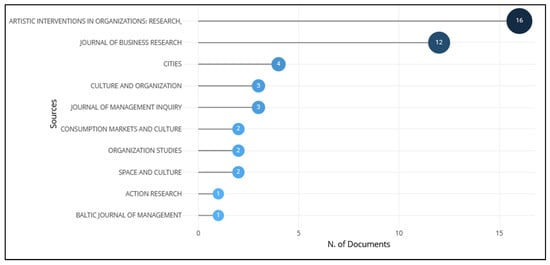
Figure 11.
The most influential journals.
- -
- “Artistic intervention in organization”: with 16 papers, for a rate of 36.3%.
- -
- “Journal of business research”: with 12 documents, for a rate of 27.2%.
These journals were chosen by the authors for two reasons (Figure 12): firstly, because they are primarily concerned with art in the business sphere, and secondly, because of the authors’ authorship links.
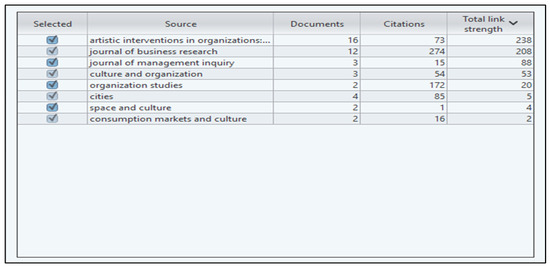
Figure 12.
List of main sources.
The “Consumption markets and culture” journal constitutes a single cluster that is slightly less connected to the others, with a total of two links to the “Journal of business research” journal.
This journal stands out due to its emphasis on the utilization of art within the marketing realm, specifically highlighting the concept of art infusion (Figure 13).
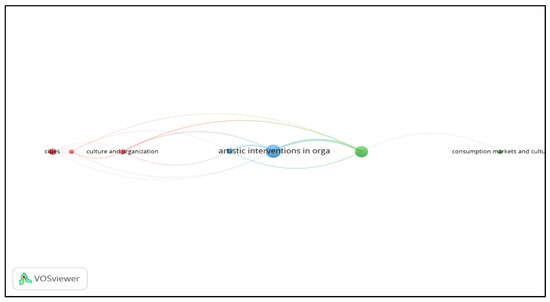
Figure 13.
Diagram of bibliographic coupling (sources).
The bibliometric analysis, in particular its bibliographic coupling, resulted in Table 1 spread over 7 clusters.

Table 1.
Different trends in the use of art in an organizational context.
3.4. Co-Occurrence Analysis
The coexistence of multiple words or linguistic elements within the same statement, such as a sentence, paragraph, or excerpt, allows us to explore the connections among various elements concerning the integration of art in management.
The co-occurrence analysis reveals the presence of seven distinct clusters (Figure 14), each represented by a different color. The green cluster is the most extensive, encompassing terms related to artistic intervention, approach, organization, creation, and development, all contributing to the field of art-based management.
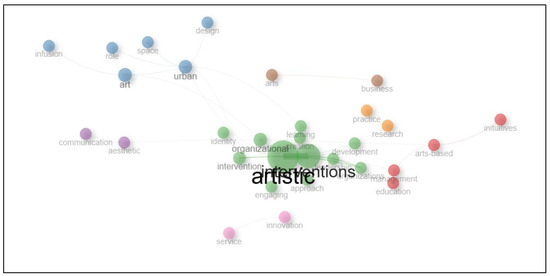
Figure 14.
Co-occurrence network by R bibliometrix.
Another cluster, depicted in blue, groups terms closely associated with the domain of urban planning, featuring words such as space, design, and infusion.
In contrast, the red cluster comprises words such as initiatives, education, and management. On the other hand, the remaining four clusters are smaller and pertain to terms such as service and innovation, as well as the intersection of art and business.
4. Discussion
Indeed, research on the integration of art in management and business has sparked the interest of scholars and management science experts, as evidenced by the main finding of the bibliometric analysis, which reveals a significant number of authors engaged in this theme. The utilization of art in a managerial context is a widespread practice among numerous companies, who view it as a valuable management tool. This increasing trend can be partially attributed to the belief that artistic intervention can contribute to enhancing corporate performance (Ferreira 2018), particularly through its influence on fostering innovation potential.
This trend was initiated by the works of Schiuma (2011), which made a significant contribution by characterizing the use of art in an organizational context. The definition proposed by this author was based on scattered practices observed in certain companies that integrated art into their activities. However, it was Adler (2006) who first emphasized the mobilization of art-based approaches within the business sphere and the main reasons behind this adoption.
The software results led to the identification of seven clusters (bibliographic coupling analysis), as previously indicated in the table above. These clusters group articles that present similar positions concerning artistic interventions. However, a thorough analysis of their content reveals some peculiarities.
It is observed that several articles were published within the same period, mainly from 2014 onwards. Particularly, Antal and her co-authors adopted a different approach in their interpretation of art-based initiatives, emphasizing the value that art brings to a company or organization in a general sense (Berthoin Antal 2011). This line of thought is shared by several authors, focusing solely on the beneficial function (marketing, communication, human resources, etc.) of this added value.
A trend emerged with Schiuma regarding the classification of artistic interventions in companies and their objectives, which partially structured the concept of art-based management. With the peak in 2015, this trend further strengthened through the evaluation of the overall impact of art. The scholarly production addresses themes related to the presence of artists as actors in an experience or their involvement in a project, as well as the integration of art into management actions.
Several authors, such as Bargenda (2019), Antal et al. (2018), and Sutherland (2013), have focused on the goals of creativity and leadership, driven by the increasing importance of managerial innovation within companies. However, none of the articles in the studied sample adopted innovation as a framework to address art-based initiatives. What distinguishes this approach is its focus on the economic and commercial value generated by these artistic interventions within the company, considering art as a value-creating tool primarily at the operational level. It is worth noting that this value creation relies on an emotional process, supported by the use of cognitive and emotional evaluation models (Estes et al. 2018).
Another line of thought emerged in 2019, marking a new momentum in studies centered on art and business, by adopting a strategic perspective, particularly in the realm of corporate social responsibility (CSR) practices. Among these works, Bargenda (2019) explored the connections between art and strategic communication, as well as brand management. Additionally, Cuny et al. (2020) examined the role of aesthetic experience as a means of infusing art into the context of services. However, this scholarly production has neglected the human factor, which plays a crucial role in the decision to use art in organizations. In response to this need, Berthoin Antal et al. (2019) studied the influence of a leader’s profile, including their demographic characteristics and level of education, on the mobilization of art in a company.
In the selected sample of 69 articles, the year 2021 marks a turning point in the evolution of thinking about art-based management. This shift can be attributed to two reasons related to the COVID-19 crisis. Firstly, due to confinement and social distancing measures, implementing artistic interventions within companies became very challenging. Secondly, the financial and economic impact of the crisis exerted pressure on the operational budgets of companies, making it difficult to justify the use of art to stakeholders.
5. Limitations and Perspectives
In identifying the main limitations of the article, several key points can be highlighted. Firstly, there is a lack of a unified and clear concept to designate the utilization of art in an organizational context, which hampers the coherent structuring of ideas on the subject. Secondly, conducting a co-citation analysis is not feasible due to the heterogeneity of impact studies, with variables varying from one article to another, and the diverse fields of action related to this utilization, such as leadership, value creation, and sensemaking, among others. A third limitation pertains to the practices themselves of employing art, which lack universality, a common formality, or a shared appellation, leading to the exclusion of several articles during data collection from the Scopus database.
Author Contributions
Conceptualization, L.S. and D.P.; methodology, A.K.; validation, D.P., A.K., and V.L.; formal analysis, D.P.; investigation, V.L., D.P., A.K., and L.S.; resources, A.K., V.L., D.P., and L.S.; data curation, A.K., D.P., and L.S.; writing—original draft preparation, D.P. and V.L.; writing—review and editing, A.K., D.P., and L.S.; visualization, D.P.; supervision, L.S. and D.P.; project administration, D.P. All authors have read and agreed to the published version of the manuscript.
Funding
This research received no external funding.
Institutional Review Board Statement
Not applicable.
Informed Consent Statement
Not applicable.
Data Availability Statement
Not applicable.
Conflicts of Interest
The authors declare no conflict of interest.
Note
| 1 | Berthoin Antal and Antal are the same author. |
References
- Adler, Nancy J. 2006. The arts & leadership: Now that we can do anything, what will we do? Academy of Management Learning & Education 5: 486–99. [Google Scholar]
- Antal, Ariane Berthoin. 2009. Transforming Organizations with the Arts. Research Framework for Evaluating the Effects of Artistic Interventions in Organizations, TIILTEurope. Available online: https://wzb.eu/system/files/docs/dst/wipo/researchreport.pdf (accessed on 3 August 2023).
- Antal, Ariane Berthoin. 2015a. Artistic interventions in organizations: Beyond the fad. In Handbook of Research on Management Ideas and Panaceas: Adaptation and Context. Cheltenham: Edward Elgar Publishing, p. 320. [Google Scholar]
- Antal, Ariane Berthoin. 2015b. The studio in the firm: A study of four artistic intervention residencies. In Studio Studies. Oxfordshire: Routledge, pp. 175–90. [Google Scholar]
- Antal, Ariane Berthoin, and Anke Strauss. 2013. Artistic Interventions in Organisations: Finding Evidence of Values-Added. Berlin: Creative clash report. [Google Scholar]
- Antal, Ariane Berthoin, and Anke Strauß. 2014. Not only art’s task—Narrating bridges between unusual experiences with art and organizational identity. Scandinavian Journal of Management 30: 114–23. [Google Scholar] [CrossRef]
- Antal, Ariane Berthoin, and Anke Strauß. 2015. Multistakeholder perspectives on searching for evidence of values-added in artistic interventions in organizations. In Artistic Interventions in Organizations. Oxfordshire: Routledge, pp. 37–59. [Google Scholar]
- Antal, Ariane Berthoin, and Gervaise Debucquet. 2019. Artistic interventions in organizations as intercultural relational spaces for identity development. Organization and Newness: Discourses and Ecologies of Innovation in the Creative University 5: 149. [Google Scholar]
- Antal, Ariane Berthoin, Gervaise Debucquet, and Sandrine Frémeaux. 2018. Meaningful work and artistic interventions in organizations: Conceptual development and empirical exploration. Journal of Business Research 85: 375–85. [Google Scholar] [CrossRef]
- Azmat, Fara, Ahmed Ferdous, Ruth Rentschler, and Emma Winston. 2018. Arts-based initiatives in museums: Creating value for sustainable development. Journal of Business Research 85: 386–95. [Google Scholar] [CrossRef]
- Bargenda, Angela. 2019. Aesthetic CSR Communication: A global perspective on organizational art collections. In Responsible Organizations in the Global Context: Current Challenges and Forward-Thinking Perspectives. Berlin/Heidelberg: Springer, pp. 117–32. [Google Scholar]
- Barone, Tom, and Elliot Eisner. 2012. Arts-based educational research. In Handbook of Complementary Methods in Education Research. Oxfordshire: Routledge, pp. 95–109. [Google Scholar]
- Barry, Daved, and Stefan Meisiek. 2010. Seeing more and seeing differently: Sensemaking, mindfulness, and the workarts. Organization Studies 31: 1505–30. [Google Scholar] [CrossRef]
- Berthoin Antal, Ariane. 2011. Managing Artistic Interventions in Organisations: A Comparative Study of Programmes in Europe. Available online: https://www.ssoar.info/ssoar/handle/document/26762 (accessed on 3 August 2023).
- Berthoin Antal, Ariane, Gervaise Debucquet, and Sandrine Frémeaux. 2019. When top management leadership matters: Insights from artistic interventions. Journal of Management Inquiry 28: 441–57. [Google Scholar] [CrossRef]
- Beyes, Timon. 2010. Uncontained: The art and politics of reconfiguring urban space. Culture and Organization 16: 229–46. [Google Scholar] [CrossRef]
- Beyes, Timon. 2015. Fictions of the possible: Art, the city, and public entrepreneurship. Journal of Management Inquiry 24: 445–49. [Google Scholar] [CrossRef]
- Beyes, Timon, and Chris Steyaert. 2011. The ontological politics of artistic interventions: Implications for performing action research. Action Research 9: 100–15. [Google Scholar] [CrossRef]
- Beyes, Timon, and Chris Steyaert. 2013. Strangely familiar: The uncanny and unsiting organizational analysis. Organization Studies 34: 1445–65. [Google Scholar] [CrossRef]
- Biehl-Missal, Brigitte. 2012. Using artistic form for aesthetic organizational inquiry: Rimini Protokoll constructs Daimler’s Annual General Meeting as a theatre play. Culture and Organization 18: 211–29. [Google Scholar] [CrossRef]
- Biehl-Missal, Brigitte, and A. Berthoin Antal. 2011. The impact of arts-based initiatives on people and organizations: Research findings, challenges for evaluation and research, and caveats. In Creative Partnerships: Culture in Business and Business in Culture. Wola: Narodowe Centrum Kultury. [Google Scholar]
- Brellochs, Mari, and Henrik Schrat. 2005. Product & Vision: An Experimental Set-Up between Art and Business. Available online: https://www.researchgate.net/publication/350789232_Using_Visual_Art_in_Product_Design_and_Consumer_Responses_The_Moderating_Role_of_Product_Type (accessed on 21 April 2023).
- Carlucci, Daniela, and Giovanni Schiuma. 2018. The power of the arts in business. Journal of Business Research 85: 342–47. [Google Scholar] [CrossRef]
- Cheng, Jen-Son, Yong Xiang, Peter J. Sher, and Chia-Wei Liu. 2018. Artistic intervention, intellectual capital, and service innovation: A case study of a Taiwan’s hotel. Service Business 12: 169–201. [Google Scholar] [CrossRef]
- Chia, Robert. 1996. Teaching paradigm shifting in management education: University business schools and the entrepreneurial imagination. Journal of Management Studies 33: 409–28. [Google Scholar] [CrossRef]
- Cuny, Caroline, Mathieu Pinelli, Marianela Fornerino, and Axel deMarles. 2020. Experiential art infusion effect on a service’s brand: The role of emotions. Journal of Marketing Management 36: 1055–75. [Google Scholar] [CrossRef]
- Darsø, Lotte. 2004. Artful Creation: Learning Tales of Arts-in-Business. Copenhagen: Samfundslitteratur. [Google Scholar]
- Darsø, Lotte. 2015. Arts-in-business from 2004 to 2014: From experiments in practice to research and leadership development. In Artistic Interventions in Organizations. Oxfordshire: Routledge, pp. 18–34. [Google Scholar]
- De Groot, Steven. 2020. Collaboration of creative professionals with companies (CoCreaCo): Antecedent conditions for collaboration in crossovers. Journal of Work-Applied Management 12: 159–74. [Google Scholar] [CrossRef]
- De Molli, Federica. 2019. An Aesthetic Account of Space: A Report on Recent Developments in Organizational Research. Milan: Franco Angeli, pp. 38–63. [Google Scholar]
- Debenedetti, Stéphane, and Véronique Perret. 2019. De l’art ou du boulot? L’intervention artistique dans les organisations. Paris: La Découverte. [Google Scholar]
- Debenedetti, Stéphane, Véronique Perret, and Géraldine Schmidt. 2019. Les méthodes de recherche basées sur l’art. In Méthodes de Recherche Qualitatives Innovantes. Paris: Economica, pp. 63–86. [Google Scholar]
- Estes, Zachary, Luisa Brotto, and Bruno Busacca. 2018. The value of art in marketing: An emotion-based model of how artworks in ads improve product evaluations. Journal of Business Research 85: 396–405. [Google Scholar] [CrossRef]
- Ferreira, Fernando A. F. 2018. Mapping the field of arts-based management: Bibliographic coupling and co-citation analyses. Journal of Business Research 85: 348–57. [Google Scholar] [CrossRef]
- Ferreira, João J. M., Fernando A. F. Ferreira, Cristina I. M. A. S. Fernandes, Marjan S. Jalali, Mário L. Raposo, and Carla S. Marques. 2016. What do we [not] know about technology entrepreneurship research? International Entrepreneurship and Management Journal 12: 713–33. [Google Scholar] [CrossRef]
- Ferro-Thomsen, Martin. 2009. Organizational Art: A Study of Art at Work in Organizations. Copenhagen: Projekt-& Karrierevejledningen, Københavns Universitet. [Google Scholar]
- Fougère, Martin. 2022. Resignifying corporate responsibility in performative documentaries. Journal of Management Inquiry 31: 286–306. [Google Scholar] [CrossRef]
- Fraser, Kimberly Diane, and Fatima Al Sayah. 2011. Arts-based methods in health research: A systematic review of the literature. Arts & Health 3: 110–45. [Google Scholar]
- Gao, Han, Feng-Yan Huang, and Zhi-Ping Wang. 2018. Research trends of macrophage polarization: A bibliometric analysis. Chinese Medical Journal 131: 2968–75. [Google Scholar] [CrossRef]
- Grant, Kim. 2017. All about Process: The Theory and Discourse of Modern Artistic Labor. University Park: Penn State Press. [Google Scholar]
- Gupta, Mansi, and Rakesh Mohan Joshi. 2023. Art infusion phenomenon: A systematic literature review. Journal of Product & Brand Management 32: 235–56. [Google Scholar]
- Hagtvedt, Henrik, and Vanessa M. Patrick. 2008. Art infusion: The influence of visual art on the perception and evaluation of consumer products. Journal of Marketing Research 45: 379–89. [Google Scholar] [CrossRef]
- Homayoun, Sogol, and Danah Henriksen. 2018. Creativity in business education: A review of creative self-belief theories and arts-based methods. Journal of Open Innovation: Technology, Market, and Complexity 4: 55. [Google Scholar] [CrossRef]
- Ippolito, Linda M., and Nancy J. Adler. 2015. From aspiration to evidence: Music, leadership and organizational transformation. In Artistic Interventions in Organizations. London: Routledge, pp. 123–48. [Google Scholar]
- Jahnke, Marcus. 2015. A newspaper changes its identity through an artistic intervention. In Artistic Interventions in Organizations. Oxfordshire: Routledge, pp. 77–89. [Google Scholar]
- Joy, Annamma, and John F. Sherry Jr. 2003. Speaking of art as embodied imagination: A multisensory approach to understanding aesthetic experience. Journal of Consumer Research 30: 259–82. [Google Scholar] [CrossRef]
- Katz-Buonincontro, Jennifer. 2018. Creativity for whom? Art education in the age of creative agency, decreased resources, and unequal art achievement outcomes. Art Education 71: 34–37. [Google Scholar] [CrossRef]
- Kerr, Cheryl, and Cathryn Lloyd. 2008. Developing creativity and innovation in management education: An artful event for transformative learning. Paper presented at Fourth Art of Management and Organisation Conference, Banff, AB, Canada, September 9–12; pp. 1072–89. [Google Scholar]
- Koronaki, Eirini, Antigone G. Kyrousi, and George G. Panigyrakis. 2018. The emotional value of arts-based initiatives: Strengthening the luxury brand–consumer relationship. Journal of Business Research 85: 406–13. [Google Scholar] [CrossRef]
- Lafaire, Ana Paula, Ari Kuismin, Johanna Moisander, and Leni Grünbaum. 2022. Interspace for empathy: Engaging with work-related uncertainty through artistic intervention in management education. Culture and Organization 28: 227–44. [Google Scholar] [CrossRef]
- Le Bas, Christian. 2019. Faut-il suivre Un paléoanthropologue dans l’entreprise? Entreprise & société 2018: 203–17. [Google Scholar]
- Leavy, Patricia. 2018. Introduction to arts-based research. In Handbook of Arts-Based Research. New York: Guilford Publications, pp. 3–21. [Google Scholar]
- Lipovetsky, Gilles, and Jean Serroy. 2013. L’esthétisation du monde. Vivre à l’âge du capitalisme artiste. Paris: Gallimard. [Google Scholar]
- Meamber, Laurie A. 2015. Commentary on learning to talk like an (urban) woodsman: An artistic intervention. Consumption Markets & Culture 18: 559–68. [Google Scholar]
- Meisiek, Stefan, and Daved Barry. 2015. Organizational studios: Enabling innovation. In Artistic Interventions in Organizations. Oxfordshire: Routledge, pp. 225–38. [Google Scholar]
- Merigó, José M., Alicia Mas-Tur, Norat Roig-Tierno, and Domingo Ribeiro-Soriano. 2015. A bibliometric overview of the Journal of Business Research between 1973 and 2014. Journal of Business Research 68: 2645–53. [Google Scholar] [CrossRef]
- Modrak, Rebekah. 2015. Learning to talk like an urban woodsman: An artistic intervention. Consumption Markets & Culture 18: 539–58. [Google Scholar]
- Müller, Anna-Lisa. 2019. Voices in the city. On the role of arts, artists and urban space for a just city. Cities 91: 49–57. [Google Scholar] [CrossRef]
- Nissley, Nick. 2010. Arts-based learning at work: Economic downturns, innovation upturns, and the eminent practicality of arts in business. Journal of Business Strategy 31: 8–20. [Google Scholar] [CrossRef]
- Nisula, Anna-Maija, Aino Kianto, and Tatiana Andreeva. 2019. What can knowledge-creating organisations learn from theatrical improvisation? In Knowledge Management, Arts, and Humanities: Interdisciplinary Approaches and the Benefits of Collaboration. Cham: Springer, pp. 55–75. [Google Scholar]
- Oh, Hyunjoo, Ha Kyung Lee, Jimin Kim, and Ho Jung Choo. 2018. Effects of art in retail environments. The International Review of Retail, Distribution and Consumer Research 28: 294–319. [Google Scholar] [CrossRef]
- Paolino, Chiara, and Ariane Berthoin Antal. 2020. Sergio Rossi and Its Magic Kingdom: Artistic Interventions, Brand Identity Renewal, and Stakeholder Awareness. In The Artification of Luxury Fashion Brands: Synergies, Contaminations, and Hybridizations. Cham: Palgrave Pivot, pp. 33–61. [Google Scholar]
- Paolino, Chiara, and Daniela Aliberti. 2019. Artistic interventions for organizational development: Case studies from Italy. In The Routledge Companion to Arts Management. Oxfordshire: Routledge, pp. 378–94. [Google Scholar]
- Pässilä, Anne, Tuija Oikarinen, and Anne Kallio. 2013a. Creating dialogue by storytelling. Journal of Workplace Learning 25: 159–77. [Google Scholar] [CrossRef]
- Pässilä, Anne, Tuomo Uotila, and Helinä Melkas. 2013b. Facilitating future-oriented collaborative knowledge creation by using artistic organizational innovation methods: Experiences from a Finnish wood-processing company. Futures 47: 59–68. [Google Scholar] [CrossRef]
- Phanuel, Dominique. 2021a. Art, Management et Vision Stratégique des Dirigeants de PME: Le modèle «Art-Vi. ST». Available online: https://hal.science/hal-03268313/document (accessed on 14 April 2023).
- Phanuel, Dominique. 2021b. Art et Management: Entre “Managérialisation de l’art” et “Esthétisation du Management”. Available online: https://hal.science/hal-03259994/document (accessed on 17 April 2023).
- Pluchart, Jean-Jacques. 2017. Vers une nouvelle esthétique bancaire. Vie & sciences de l’entreprise 1: 9–21. [Google Scholar]
- Pöppel, Jürgen, Jörg Finsterwalder, and Rebecca A. Laycock. 2018. Developing a film-based service experience blueprinting technique. Journal of Business Research 85: 459–66. [Google Scholar] [CrossRef]
- Raviola, Elena, and Claudia Schnugg. 2015. Fostering creativity through artistic interventions: Two stories of failed attempts to commodify creativity. In Artistic Interventions in Organizations. Oxfordshire: Routledge, pp. 90–106. [Google Scholar]
- Rizzo, Agatino, and Michail Galanakis. 2015. Transdisciplinary urbanism: Three experiences from Europe and Canada. Cities 47: 35–44. [Google Scholar] [CrossRef]
- Rodríguez-Bolívar, Manuel Pedro, Laura Alcaide-Muñoz, and Manuel Jesús Cobo. 2018. Analyzing the scientific evolution and impact of e-Participation research in JCR journals using science mapping. International Journal of Information Management 40: 111–19. [Google Scholar] [CrossRef]
- Sandberg, Berit. 2019. Art hacking for business innovation: An exploratory case study on applied artistic strategies. Journal of Open Innovation: Technology, Market, and Complexity 5: 20. [Google Scholar] [CrossRef]
- Schiuma, Giovanni. 2009. Mapping Arts-Based Initiatives. London: Arts & Business, pp. 3–7. [Google Scholar]
- Schiuma, Giovanni. 2011. The Value of Arts for Business. Cambridge: Cambridge University Press. [Google Scholar]
- Schiuma, Giovanni. 2017. Arts catalyst of creative organizations for the fourth industrial revolution. Journal of Open Innovation: Technology, Market, and Complexity 3: 20. [Google Scholar] [CrossRef]
- Schiuma, Giovanni, and Daniela Carlucci. 2015. Assessing the business impact of arts-based initiatives. In Artistic Interventions in Organizations. Oxfordshire: Routledge, pp. 60–74. [Google Scholar]
- Schnugg, Claudia. 2011. The Potential of Arts-based Initiatives in Business Organizations. Paper presented at 27ème EGOS Colloquium, Gothenburg, Sweden, July 6–9. [Google Scholar]
- Seo, Yuri, Felix Septianto, and Eunju Ko. 2022. The role of cultural congruence in the art infusion effect. Journal of Consumer Psychology 32: 634–51. [Google Scholar] [CrossRef]
- Simeone, Luca, Giustina Secundo, and Giovanni Schiuma. 2018. Arts and design as translational mechanisms for academic entrepreneurship: The metaLAB at Harvard case study. Journal of Business Research 85: 434–43. [Google Scholar] [CrossRef]
- Skoglund, Annika, and Robin Holt. 2021. Spatially organizing future genders: An artistic intervention in the creation of a hir-toilet. Human Relations 74: 1007–32. [Google Scholar] [CrossRef]
- Sköldberg, Ulla, Jill Woodilla, and Ariane Berthoin Antal, eds. 2015. Artistic Interventions in Organizations. Research, Theory and Practice. Oxfordshire: Routledge. [Google Scholar]
- Sorsa, Virpi, Heini Merkkiniemi, Nada Endrissat, and Gazi Islam. 2018. Little less conversation, little more action: Musical intervention as aesthetic material communication. Journal of Business Research 85: 365–74. [Google Scholar] [CrossRef]
- Strand, Mia, Nina Rivers, and Bernadette Snow. 2022. Reimagining ocean stewardship: Arts-based methods to ‘hear’and ‘see’Indigenous and local knowledge in ocean management. Frontiers in Marine Science 9: 886632. [Google Scholar] [CrossRef]
- Strauß, Anke. 2018. Value-creation processes in artistic interventions and beyond: Engaging conflicting orders of worth. Journal of Business Research 85: 540–45. [Google Scholar] [CrossRef]
- Styhre, Alexander, and Jonas Fröberg. 2015. Artistic interventions as détournement and constructed situations. In Artistic Interventions in Organizations. Oxfordshire: Routledge, pp. 107–20. [Google Scholar]
- Sutherland, Ian. 2013. Arts-based methods in leadership development: Affording aesthetic workspaces, reflexivity and memories with momentum. Management Learning 44: 25–43. [Google Scholar] [CrossRef]
- Taylor, Steven S., and Donna Ladkin. 2009. Understanding arts-based methods in managerial development. Academy of Management Learning & Education 8: 55–69. [Google Scholar]
- Thévenot, Laurent, and Luc Boltanski. 1991. De la justification. Les économies de la grandeur. Paris: Gallimard. [Google Scholar]
- Vergara-Perucich, José Francisco. 2021. Urban design as a form of agonistic democratic expression. Space and Culture 24: 456–72. [Google Scholar] [CrossRef]
- Weick, Karl E. 2007. Drop your tools: On reconfiguring management education. Journal of Management Education 31: 5–16. [Google Scholar] [CrossRef]
- Yams, Nina Bozic. 2015. Choreographing creative processes for innovation. In Artistic Interventions in Organizations. Oxfordshire: Routledge, pp. 149–63. [Google Scholar]
- Yams, Nina Bozic. 2018. The impact of contemporary dance methods on innovative competence development. Journal of Business Research 85: 494–503. [Google Scholar] [CrossRef]
- Yang, Huiru, Delia Vazquez, and Marta Blazquez. 2021. Creative Art-based Initiatives Enabling Value Co-creation in the Luxury Fashion Industry. In Creativity and Marketing: The Fuel for Success. Bingley: Emerald Publishing Limited, pp. 133–47. [Google Scholar]
- Zambrell, Katarina. 2015. 11 Managers in artistic interventions and their leadership approach. In Artistic Interventions in Organizations: Research, Theory and Practice. London and New York: Routledge, p. 185. [Google Scholar]
- Zambrell, Katarina. 2016. Managers’ identity construction at work: Artistic interventions as triggers for identity work. Organizational Aesthetics 5: 34–67. [Google Scholar]
Disclaimer/Publisher’s Note: The statements, opinions and data contained in all publications are solely those of the individual author(s) and contributor(s) and not of MDPI and/or the editor(s). MDPI and/or the editor(s) disclaim responsibility for any injury to people or property resulting from any ideas, methods, instructions or products referred to in the content. |
© 2023 by the authors. Licensee MDPI, Basel, Switzerland. This article is an open access article distributed under the terms and conditions of the Creative Commons Attribution (CC BY) license (https://creativecommons.org/licenses/by/4.0/).